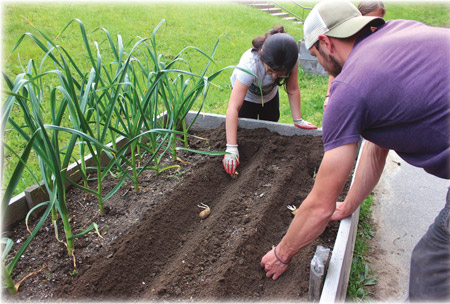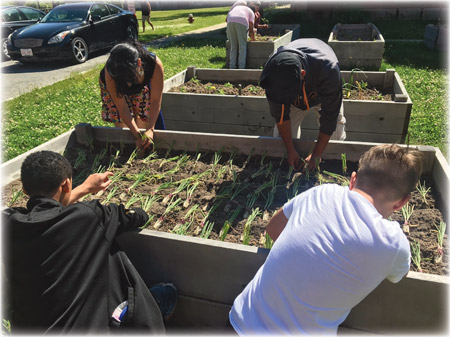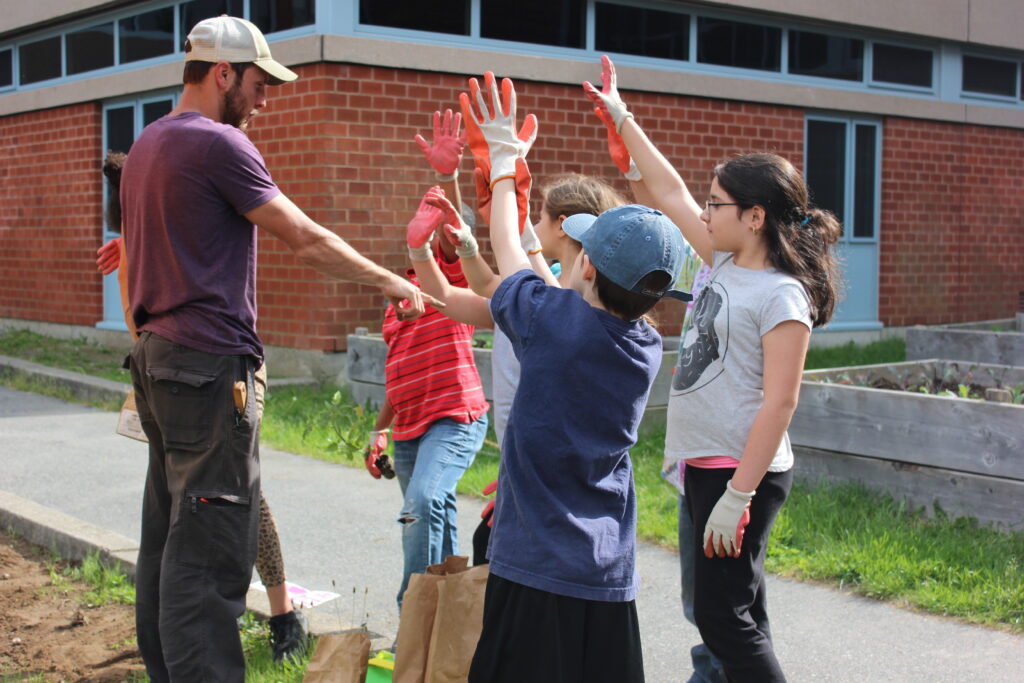By Kendra Murray. Photos: The Marion Institute.
Four initiatives comprise this Farm to School movement in New Bedford: classroom, cafeteria, community, and gardens.

Photos: The Marion Institute
As I write this article, there is a delicious bowl of wholegrain pasta loaded with veggies, beans, homemade sauce, and fresh chard picked from my garden this afternoon in front of me. I know the importance of whole grains, dark leafy greens, vegetables, and beans for optimal health. My dinner is packed with antioxidants, fiber, protein, and many vitamins and minerals. Some ingredients are local; I’m just 20 steps away from where they were harvested. I know what’s needed to nourish my body and am deeply connected to my food sources.
However, I also know that I’m very lucky to be educated about nutrition, the complexity of our industrial agricultural systems, and best practices for growing my own food. Many don’t know where their next meal is coming from, never mind if it’s actually healthy for them. Growing vegetables? That’s what great-grandparents did when they immigrated to America. Learning to grow their own food certainly isn’t a priority for many families, especially those living in urban areas.
Grow Education, a program of the Marion Institute, hopes to change all of that. Grow Education has been working with the New Bedford Public School System for the past eight years, providing third grade students with knowledge of their food from seed to plate. Four initiatives comprise this Farm to School movement in New Bedford: classroom, cafeteria, community, and gardens. Adam Davenport, the Grow Education Program Manager, took the time to update me on some of the amazing things that the Marion Institute and Grow Education have been working on over the past couple of years.
The Grow program worked with six New Bedford elementary schools this past year and hopes to expand to all 19 elementary schools in the city by the end of next summer. At each site, 30-inch raised-bed gardens made of composite decking were constructed. This is a durable material chosen for its longevity and sturdiness. In addition to building these gardens, Grow Education has created lesson plans that meet the Massachusetts science, math, and health curriculum frameworks, enabling these gardens to become outdoor classrooms.
Teachers are provided with professional development in the late summer months to prepare for teaching in September. Students learn about plant anatomy and life cycles, as well as climate and climate change and the impact these have on planting and growing. Lesson plans also highlight nutrition and the importance of healthy food and lifestyle choices. The gardens allow students to observe how food is grown, and that it doesn’t just show up on the grocery store shelves and bins!

When many meals are eaten outside of the home, it’s important that they are nutritious and, of course, appealing to children. Photos: The Marion Institute
Gardening begins in the fall, with students planting garlic. For many, this is the first time ever planting a “seed.” Although the garlic won’t be ready for harvest until late spring of the following year, their education continues through the cold months with local farmers coming in to talk to students, and additional indoor classroom learning. In the spring, students harvest their overwintered garlic and begin planting crops that they can harvest in early summer.
When school is out of session, these gardens become community plots that anyone can come in to use and harvest from. This is especially important in low-income neighborhoods. Students are encouraged to tell their families about the gardens and come back to visit and harvest produce in the summer months.
In addition to having access to the Grow gardens, the community is also engaged in other ways with this Farm to School program. After a new food services director, Rob Shaheen, was hired in New Bedford in 2018, there has been a greater focus on getting healthy and local foods into the school system. Infrastructure is being updated so that schools can actually cook and prepare foods—not just reheat frozen processed foods. A central kitchen will be created, and soon there will be more appropriate facilities to store local food.
When discussing menu items, parents, guardians, and caregivers will have opportunities to provide recommendations and feedback to the food services department, local chefs, and a nutritionist, and to discuss culturally relevant food items. New Bedford is a very diverse city, and it is important that different heritages are represented in food items served to students. Recipes are shared and might be altered slightly to meet nutritional requirements and use ingredients that are readily available. How cool is that?
New Bedford Public Schools also run an interesting, state-funded fruit and vegetable program. Every week, twice a week, students taste-test different fruits or vegetables. They don’t have to like it, but they do have to at least try it. This is a fantastic way to introduce children to foods they may not have eaten at home. There is such a vast array of produce out there and these kids are getting to try all of it! If they see on their plates in subsequent weeks foods they’ve already tried, they will be more likely to eat it rather than just throw it away. The same goes for gardening; if they see food items that they’ve learned to grow, students are more likely to give it a chance rather than toss it in the bin.

Adam really illustrates the importance of the Grow Education program with a few eye-opening statistics. New Bedford schools are able to offer free lunch to all of their students through the Community Eligibility Provision, or CEP. School districts qualify if 40% or more of the students’ families receive SNAP (Supplemental Nutrition Assistance Program) or similar benefits, which is the case in New Bedford. If a student is eating breakfast and lunch all 180 days school is in session, it equates to 33% of his or her annual meals. In high needs areas, some schools even offer dinner during the academic year, which means more than 50% of a student’s meals is coming from their school.
Grow Education is truly doing amazing work. This coming year, Grow will host three FoodCorps (a grantee of AmeriCorps) members at different New Bedford schools to assist with teaching about healthy eating, nutrition, and agriculture in the classroom. These service members also teach lessons in the garden and get their hands dirty planting seeds. Additionally, FoodCorps members will work in cafeterias with food service department staff, surveying and encouraging students. There is a lot of work to be done, and these service members will hit the ground running and help Grow—well, grow.
A lot of work also needs to be done in the food justice sector overall and Grow Education and the New Bedford public school system are making huge strides. Not only are students learning how to grow food, but the greater community has gathered around these gardens. As climate change, social issues, and global pandemics cause stress and confusion, we can all come together to learn about the food we eat and grow as a community.
The Marion Institute
Grow Southcoast
202 Spring Street
Marion, MA 02738
(508) 748-0816
www.MarionInstitute.org
New Bedford Public Schools Food and Nutrition Services
455 County Street
New Bedford, MA 02740
(508) 997-4511
www.NewBedfordSchools.org







